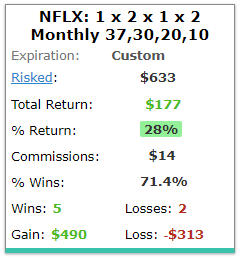The Trading Pattern in Netflix Right Before Earnings

The Trading Pattern in Netflix Right Before Earnings
Date Published: 2018-09-18
Disclaimer
The results here are provided for general informational purposes, as a convenience to the readers. The materials are not a substitute for obtaining professional advice from a qualified person, firm or corporation.LEDE
On 2018-08-28 we penned For Netflix, The 'Quiet' Period Has Meant a Consistent Pattern of Profitable Stock Option Trading. It turns out that the same pattern persists beyond that quiet period, right ahead of earnings.Netflix next has earnings due out on 2018-10-16, and 25 days before then would be 9-21-2018.
Why Look at This?
Last time we looked at this back-test we used this timing:
So, the backtest opened 40 days after earnings and closed 25 days before earnings. It turns that the pattern continues -- right where it left off.
Custom Timing
Now we'll start with timing. Here it is:
The trade opens 25 calendar days before earnings and closes the day of earnings. Note that since Netflix reports earnings after the market closes that this trade does not take on earnings risk -- it avoids it by closing before the event.
Building the Strategy Before We See the Results
We constructed a NFLX multi-leg strategy, just as we did before and have done so many other times for the S&P 500 ETF (SPY), Nvidia, Micron, Adobe, and Amazon back-tests. Here is the entire image, and then we will break it down, leg by leg.
Rather than take this is one big trade, we can actually break it into two familiar trades. This could be one way to apply this lesson in real life. That is, open 2 put spreads.
Rules
The first leg is simply long one put spread:* Long one 37/20 delta monthly put spread.
This is long one put spread


The second leg is simply short two put spreads:
* Short two 30/10 delta monthly put spreads.
This is short two put spreads


What Does This Mean?
This is casually called a ratio put spread, and specifically this is a 1 x 2 x 1 x 2 (read out loud as "1 by 2 by 1 by 2") put spread.The idea is to create an option position that:
* Creates a credit at onset.
* Has no upside risk (a stock rise to any price should be profitable).
* Has some downside bias (if the stock goes down "a little" it profits at the maximum level)
* Has a hard limit on total downside.
Broadly speaking, this is how all of that looks in a profit and loss chart at expiration:

This strategy is profitable in the green shaded area, and shows a loss in the red shaded area.
To get your bearings:
* The maximum loss starts at the lowest strike price. Any stock price there or lower shows a capped loss at its maximum.
* The maximum gain occurred right at the second-strike price (the first short strike price), which is below the initial stock price at onset of the trade.
This strategy does well in a bull market but does best in a slightly bearish market. It does worst when there is a large stock drop, but that loss is capped.
Finally, The Results
Here are the results of this strategy over the last five-years, or 20 pre-earnings periods.Track this trade idea. Get alerted for ticker `NFLX` 25 days before earnings
Here are the results of this strategy over the last two-years, or 8 pre-earnings periods.
And finally, for completeness, over the last four pre-earnings periods :
What About a Bear Market?
It's a fair question to ask how this trade did in the past during the bear market. And since it's a fair question, here is the answer.Fist we select our custom date period, in this case the bear market.

Then we look at the results:
So, during the bear market this back-test shows a winner, with a 71% win rate and a small positive return.
How to Try This Yourself
We simply used the Trade Machine® Custom Strategy builder. You can create it yourself immediately as a Trade Machine member, by simply clicking on any of the back-test links above, then click the "edit" button, and save.What Happened
In a few mouse clicks and about 30 seconds, we identified a pattern that has repeatedly turned a profit over and over again. Tap the link below to become your own option expert.Tap Here to Learn More
Risk Disclosure
You should read the Characteristics and Risks of Standardized Options.
Past performance is not an indication of future results.
Trading futures and options involves the risk of loss. Please consider carefully whether futures or options are appropriate to your financial situation. Only risk capital should be used when trading futures or options. Investors could lose more than their initial investment.
Past results are not necessarily indicative of future results. The risk of loss in trading can be substantial, carefully consider the inherent risks of such an investment in light of your financial condition.
Please note that the executions and other statistics in this article are hypothetical, and do not reflect the impact, if any, of certain market factors such as liquidity and slippage.






